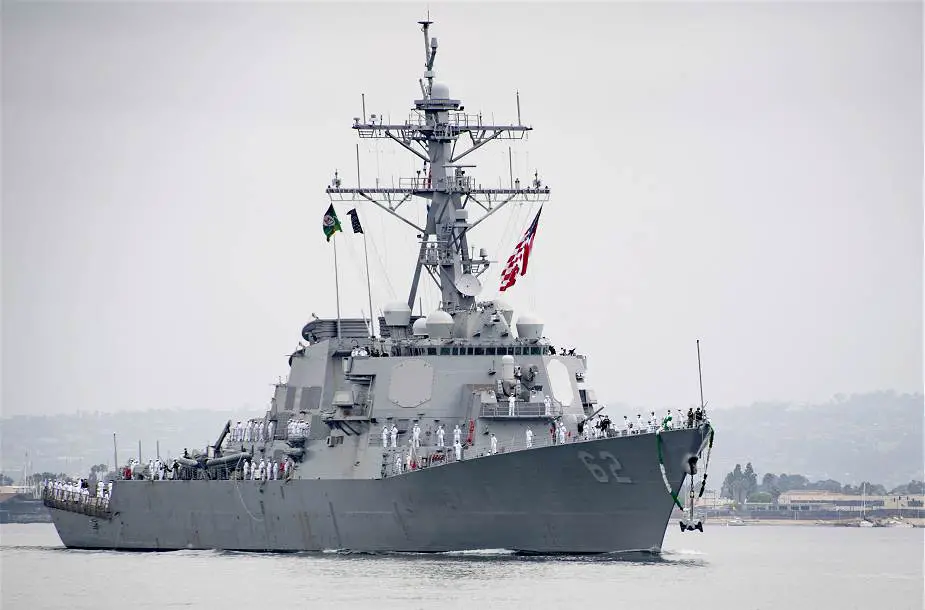According to a contract released by the U.S. doD (Department of Defense) on July 6, 2020, Lockheed Martin Rotary and Mission Systems, Baltimore, Maryland, is awarded a $12,805,321 not to exceed, indefinite-delivery/indefinite-quantity, cost-plus-fixed-fee contract for materials and engineering services required to develop and integrate technological improvements for the DDG-51 hull; mechanical and electrical machinery control systems (MCS); Littoral Combat Ship (LCS) Freedom class MCS; and Landing Helicopter Dock/A (LHD/A) MCS installed onboard current Navy ships in support of Naval Surface Warfare Center, Philadelphia Division.
Follow Navy Recognition on Google News at this link
 The DDG 51 guided-missile destroyer USS Fitzgerald (DDG 62) arrives at homeport at Naval Base San Diego following more than two years of restoration and modernization at Huntington Ingalls Industries - Ingalls Shipbuilding Division's Pascagoula, Mississippi shipyard.(Picture source U.S. Navy)
The DDG 51 guided-missile destroyer USS Fitzgerald (DDG 62) arrives at homeport at Naval Base San Diego following more than two years of restoration and modernization at Huntington Ingalls Industries - Ingalls Shipbuilding Division's Pascagoula, Mississippi shipyard.(Picture source U.S. Navy)
The services under this contract will support the development, implementation, execution and life cycle sustainment of shipboard MCS for LCS class, LHD/A class and DDG class surface ship machinery control equipment and systems, as well as serve the Logistics Management Branch of the Naval Surface Warfare Center, Philadelphia Division. This statement of work requests highly specialized services that only Lockheed Martin can support. As such, Lockheed Martin has developed proprietary test scripts and test equipment to provide for delivery and support of MCS systems and components. Work is expected to be completed by July 2026.
The U.S. Navy DDG 51 guided missile destroyers are warships that provide multi-mission offensive and defensive capabilities. Destroyers can operate independently or as part of Carrier Strike Groups, Surface Action Groups, and Expeditionary Strike Groups. This type of ship is capable of conducting Anti-Air Warfare (AAW), Anti-Submarine Warfare (ASW), and Anti-Surface Warfare (ASuW). The destroyer's armament has greatly expanded the role of the ship in strike warfare utilizing the MK-41 Vertical Launching System (VLS) of the DDG 51 class, and the Advanced Vertical Launch System (AVLS) the DDG 1000 class.
The LCS (Littoral Combat Ship) class consists of two variants, the Freedom variant and the Independence variant, designed and built by two industry teams. The Freedom variant team is led by Lockheed Martin (for the odd-numbered hulls, e.g. LCS 1). It is a steel monohull design constructed by Lockheed Martin in the Fincantieri Marinette Marine Corporation's shipyard in Marinette, Wisconsin. The Independence variant is an aluminum trimaran design originally built by an industry team led by General Dynamics Bath Iron Works for LCS 2 and LCS 4. Currently, Independence variant LCS (LCS 6 and subsequent even-numbered hulls) are constructed by Austal USA in the company's Mobile, Alabama, shipyard.
Amphibious transport dock ships are warships that embark, transport and land elements of a landing force for a variety of expeditionary warfare missions.
LPDs are used to transport and land Marines, their equipment, and supplies by embarked Landing Craft Air Cushion (LCAC) or conventional landing craft and amphibious assault vehicles (AAV) augmented by helicopters or vertical take-off and landing aircraft (MV 22). These ships support amphibious assault, special operations, or expeditionary warfare missions and serve as secondary aviation platforms for amphibious operations.



